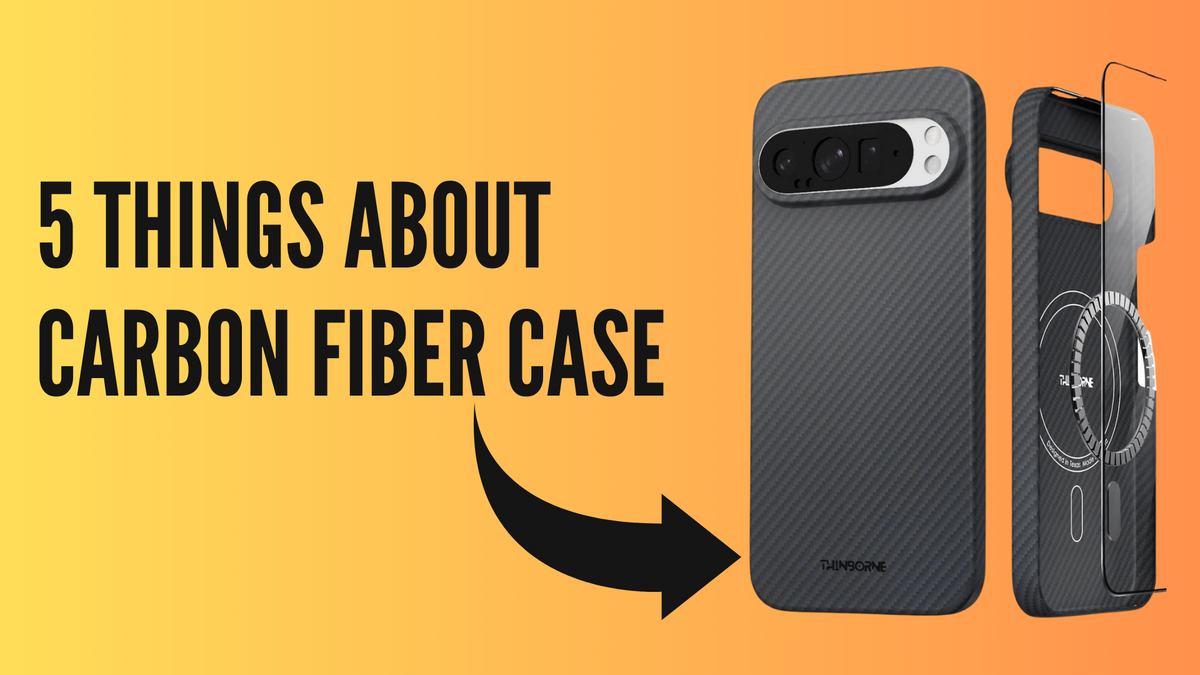
5 Things You Need To Know Before Buying A Carbon Fiber Phone Case
|
|
Temps de lecture 5 min
Vous possédez un compte ?
Connectez-vous pour payer plus vite.
|
|
Temps de lecture 5 min
For many smartphone users, a phone case is more than just protection. It's a way to express personal style and safeguard a valuable device. Carbon fiber cases have gained popularity for their lightweight yet sturdy design. But before you rush to buy one, it's important to consider some potential drawbacks of this high-tech material.
Carbon fiber is a lightweight yet strong material composed of thin, tightly packed strands of Carbon atoms arranged in a crystalline structure. It is similar to graphite but on a microscopic scale. Special fibers made from Polyacrylonitrile (PAN) or rayon are heated without oxygen to produce carbon fiber at high temperatures. This process, called Carbonization, turns the fibers into pure Carbon. After that, the fibers go through another heating process called graphitization to make them even more robust.
The result is Carbon Fiber, known for being very stiff, corrosion-resistant, and durable against wear and tear. It's a popular choice in industries like aerospace, automotive, sports equipment, and manufacturing due to its strength-to-weight ratio and ability to work with different types of resins for advanced engineering applications.
Pros:
A Carbon fiber phone case is known for their signature look: a sleek black finish with a distinct woven texture. This minimalist design exudes sophistication and pairs well with modern phone styles.
Cons:
One drawback of Carbon Fiber cases in terms of design is the limited variety available compared to cases made from other materials like TPU or Silicone. While the black woven texture is iconic, it may not offer the same level of customization or personalization options that different materials can provide.
Pros:
One of the biggest selling points of Carbon Fiber is its durability. It offers unmatched scratch resistance, ensuring your phone stays pristine even after battling through keys and coins in your pocket.
Cons:
While resistance to wear and tear is an advantage, it may result in cases showing less character or aging compared to cases made from materials that develop a patina over time. A Carbon Fiber case might not exhibit any visible wear and tear. This can be great for resale value, but for some users, it might feel like the case isn't "earning its keep."
Pros:
Carbon fiber is remarkably strong and durable. It is made to be tough and stiff
Cons:
It can break easily. Unlike materials like plastic or rubber that can bend, Carbon fiber is rigid and can crack if it gets hit hard. This brittleness comes from how Carbon fiber is made to be tough and stiff. While this toughness makes Carbon fiber cases durable, they are more likely to break when hit with force.
Pros:
Better than older metal cases that block signals more.
Cons:
Carbon Fiber has the potential to absorb microwaves, which are essential for wireless communication signals. For users in areas with weak signal strength or those who rely heavily on mobile data, even a minor signal reduction could be a concern.
Pros:
Carbon fiber and Kevlar cases are renowned for their exceptional durability and premium quality. This makes them favorites for those who want the best device protection.
Cons:
This top-tier craftsmanship and strength comes with a price tag. Specifically, Carbon fiber cases cost much more than regular plastic or silicone cases because they use advanced techniques and top-quality materials. This higher price reflects the investment needed to obtain the unmatched durability and style that Carbon fiber cases provide.
If you're looking for a case that offers benefits similar to Carbon fiber without some drawbacks, consider Aramid fiber. This lightweight yet robust material boasts excellent scratch resistance and durability, similar to Carbon fiber. However, Aramid Fiber offers a more flexible and less brittle nature. This makes it a great choice for users who prioritize style and robust protection. Moreover, Aramid Fiber cases are more affordable than Carbon fiber options. Thus, this makes it a budget-friendly option for those seeking premium protection.
Learn more here about Aramid Fiber and how it compares to other phone case materials.
It is important to thoroughly research and understand all aspects before purchasing, especially when protecting our valuable smartphones. While Carbon fiber cases may offer strength and durability, there are certainly some disadvantages that must be considered.
The lack of customization options and signal interference issue may not sit well with some users. However, before completely crossing off a Carbon fiber case from your list, it's worth considering another type of material that offers benefits similar to Aramid fiber. With its lightweight yet strong properties, Aramid fiber cases provide superior protection without the bulk or signal interference issue.
So, before you decide on a phone case, be sure to weigh out all your options. Investing in a high-quality protective case will keep your device safe for years.
Thinborne specializes in crafting thin phone cases made from aramid fiber, offering the perfect combination of style and protection without adding bulk. Visit our Amazon store to explore our collection and find the perfect fit for your phone.
Products Featured In This Blog
Carbon Fiber boasts a higher tensile strength than Aramid Fiber, which can resist greater pulling forces. However, due to its flexibility, Aramid Fiber offers superior impact resistance. Aramid fiber's ability to absorb impact without cracking makes it a strong contender for phone case applications.
The signal interference caused by Carbon fiber cases is minimal and shouldn't significantly impact GPS functionality. However, if you live in an area with weak cellular reception or rely heavily on mobile data, Aramid fiber might be a better choice due to its near-zero signal absorption.
While highly scratch-resistant, Carbon fiber's brittleness can lead to cracks or even shattering upon impact. This could damage the phone housed within the case. Aramid fiber's flexibility makes it less susceptible to breaking during falls, offering better protection against drops.

